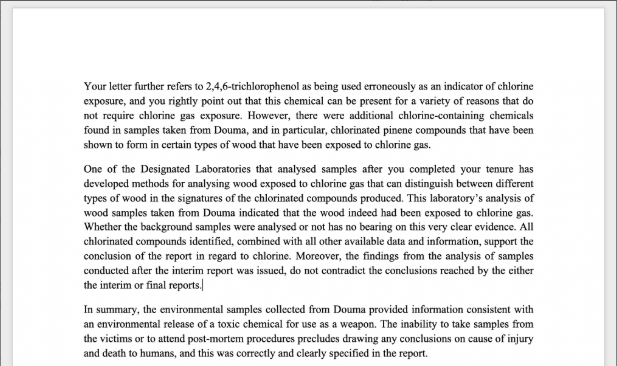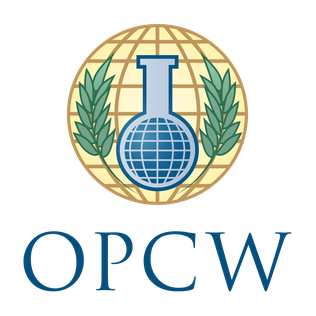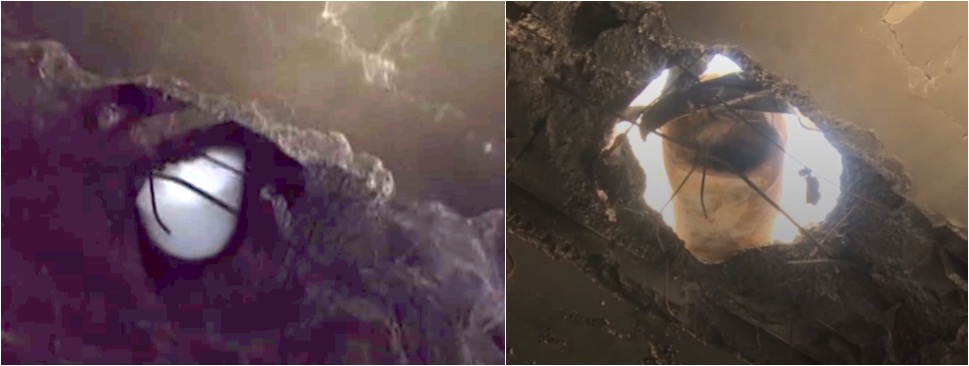Were Chemical Weapons Used in Donetsk Airport’s Last Stand?
Donetsk International Airport in Donetsk, Ukraine, served over 1.1 million passengers in 2013 before it was seized by Russian-backed rebels aligned with the Donetsk People’s Republic (DPR) in May of 2014.
Large outbursts of conflict followed in the coming months, with Ukrainian forces conducting air raids, and both the Ukrainian army and the DPR heavily shelling the area. As of Jan. 22, 2015, after heavy fighting and with few holdouts from Ukrainian forces (somewhat endearingly termed “cyborgs” for their resilience in combat), Donetsk International Airport — although essentially destroyed — is reportedly under complete control of the DPR.
The Cost of Attack
Since Jan. 16, one of the heaviest days for clashes at Donetsk airport between the DPR and Ukrainian forces, conflicting reports have arisen regarding how the DPR managed to seize the airport in its entirety.
The Organization for Security and Cooperation in Europe (OSCE), the world’s largest regional security organization with 57 member states, has been consistently monitoring the situation in Ukraine since early 2014 through its Special Monitoring Mission to Ukraine (SMM). In its most recent report published on Jan. 20, the SMM reported significant shelling in Donetsk over the past several days. Damage to civilian property up to 3km away from the Donetsk city center was observed, with residents in the area citing shelling as the cause for damage.
Multiple other instances of shelling damage in DPR-controlled territory were reported by the SMM. The Ukrainian army and the DPR traded blows for several hours each night, with the SMM noting “approximately 10 outgoing and three incoming artillery rounds” in government-controlled territory north of Donetsk, and “six outgoing artillery rounds” in government-controlled Staronativka, 48km south of Donetsk.
Chemical Agents
Perhaps the most unusual part of the SMM’s Jan. 20 report consists of an interview conducted by SMM members with a Ukrainian soldier hospitalized in government-controlled Konstantinovka, an industrial city 56km north of Donetsk. The soldier stated he was being treated for injuries sustained through combat at Donetsk airport on Jan. 19, and that “80 Ukrainian soldiers in total” had suffered similar injuries, including “uncontrollable muscle spasms, vomiting, difficulty breathing,” and in some cases, loss of consciousness.
These symptoms are consistent with exposure to certain nerve agents and choking agents. Use of nerve agents by either party is unlikely, especially considering the relatively high mortality rate of these chemical weapons along with an absence of fatalities reported among those exposed to the attack. Use of choking agents is more likely – although potentially fatal, the use of these banned weapons often results in a lower mortality rate than their neurological counterparts.
Russia and Ukraine are both signatories of the 1993 Chemical Weapons Convention. Although Ukraine confirmed it had transferred all chemical weapons in its territory to Russia in early 1992 following the collapse of the Soviet Union, Russia still possesses a non-negligible stockpile of various chemical agents. Russia possessed 40,000 metric tons of chemical weapons when the Chemical Weapons Convention was ratified in 1997, of which around 10,000 metric tons remain as of 2013.
Among the chemical weapons possessed by Russia, there are several incidentally significant agents, including:
- VR (a Soviet-developed isomer of VX)
- Sarin (GB)
- Soman (GD)
- Phosgene (CG)
Additionally, Russian news agency RT reported in 2012 that Russia still maintained “vast stockpiles” of mustard gas, lewisite, and other chemical agents.
Precursor Attacks
Another instance of alleged chemical munitions use on Donetsk airport prior to the incident on Jan. 19 was reported several days earlier, on Jan. 16, with both sides accusing the other of using chemical munitions. Russian government-owned news agency ITAR-TASS quoted DPR president Alexander Zakharchenko’s accusations of chemical weapons use by Ukrainian forces during a tour of Donetsk airport on the 16th. “After the shells burst, a pungent cloud of gas spread across the old terminal,” Zakharchenko said. “They are firing banned munitions in breach of the Geneva convention.”
ITAR-TASS similarly quoted one of their correspondents, present at the tour of Donetsk airport, as having “felt the impact of chemical substances, which made his eyes tear and caused troubled breathing.”
These accusations may not be unfounded, but are perhaps overblown; the symptoms of this precursor attack are at least partially consistent with those of illegal chemical agents, but they are also consistent with military chemical compounds such as CS gas and other riot control agents.
The use of these agents are permissible for the purposes of riot control, but remain prohibited for warfare. Nonetheless, military chemical compounds – while still dangerous and potentially fatal – are exponentially safer than explicitly prohibited chemical agents, which are designed to cause severe injury and/or death.
The Interpreter, headed by global affairs analyst James Miller and Foreign Policy columnist Michael Weiss, provides a likely debunking of the Jan. 16 attack. According to their Ukraine live blog, reports of a chemical attack were non-lethal and inconsequential:
Last week, on January 16, the Russian state-controlled media reported a possible chemical weapons attack at Donetsk airport. However, Ukrainian soldiers reported the use of a smoke screen, and we were satisfied that the use of smoke grenades accurately matched the reports of the smell of the gas and the symptoms. It seemed like a “non-story.”
Were Chemical Weapons Used?
The question remains as to whether chemical weapons were used, and by whom, on Jan. 19 in Donetsk. It has been established that the use of chemical agents in warfare, regardless of their classification, is prohibited under OPCW regulations. Yet over the past 24 hours, accusations of chemical attacks via reports on Twitter have sprung up in large number from those in the region.
Environmental factors warrant particular consideration. As noted by 22-year CBRN veteran and former United States Army Chemical Officer Dan Kaszeta, melting points are a major factor in chemical weapons use – particularly in Ukraine, which over the past week has seen temperatures ranging from 20-35°F (–7-2°C).
Many chemical agents, including those mentioned above, are most commonly found in liquid form. The melting point of sarin, an unlikely candidate for the attack due to its high fatality rate, is around –69°F (–56°C), while VX dips as low as –60°F (–51°C). Soman and phosgene have melting points as low as –44°F (–42°C) and –198°F (–128°C) respectively. According to Kaszeta, few chemical agents have sufficient vapor pressure to function effectively at Ukrainian winter temperatures, but relatively mild temperatures in Eastern Ukraine over the past several weeks may mean vapor pressure is a non-issue.
Photographic evidence and social media reports may be more convincing. Frequently retweeted and apparently original photos from biased sources in the region show corpses of soldiers with signs possibly indicative of chemical exposure. Additionally, live footage of Donetsk airport broadcast by Russian television station LifeNews on Jan. 22 shows a DPR crate with what appears to be a Russian PMK-1 gas mask on top, and the caption “by the law of knighthood, militia helps UAF out of the rubble.” Respirators do have practical use in a warzone, but the PMK-1 mask broadcast by LifeNews appears to be equipped with a CBRN cartridge, rated specifically to filter chemical, biological, radiological, and nuclear particles.
On Jan. 23, the Ukraine-aligned but independently operated Kyiv Post reported on losses at Donetsk airport. As part of the report, the paper interviewed a wounded Ukrainian soldier who “kept in touch with his comrades fighting at the airport.” The soldier, who chose to remain anonymous due to lack of authorization, detailed use of chemical weapons by DPR forces.
He said the rebels started using grenades with a nerve agent – a prohibited means of warfare – over the last weeks. “If there is vomiting it is definitely a nerve agent. If there is a closed building a person may faint over them,” he said adding that the rebels definitely used such grenades on Jan. 20.
Outside of fiction, nerve agents are typically not weaponized into handheld devices, and certainly not deployed in conflict stricken zones. Phosgene gas, however, is relatively easily weaponized in grenade form, although the Russian military doesn’t have a history of producing chemical grenades. Reports by the Kyiv Post are contentious, but weaponized phosgene with any delivery system fits the description of the unknown agent given by Ukrainian soldiers to Kyiv Post and the OSCE. Symptoms of phosgene exposure, which onset anywhere between 6 and 24 hours after exposure, include difficulty breathing, nausea and vomiting, and blurred vision.
Russia has a history of using chemical weapons in crisis situations. During the 2002 Moscow theater hostage crisis, in which Chechen separatists held hostage 850 civilians in a crowded theater and demanded the withdrawal of Russia from Chechnya, agents from the Russian FSB pumped an unknown chemical substance into the theater and launched a successful raid. 133 of the hostages died due to chemical exposure, largely as a result of Russia’s refusal to disclose the identity of the chemical to health professionals.
The DPR assumes no responsibility for any chemical attack, nor does the Ukrainian government, and it remains that the symptoms described by the hospitalized Ukrainian soldier to OSCE officials could be indicative of other, lesser types of exposure. Inhalation of debris from the shelled airport remains a major contender, as the effects from overexposure to industrial particulates may mirror certain symptoms of chemical exposure.
Several additional factors, unattainable without on-the-ground presence in Ukraine, should be taken into account: ratio of fatalities to injuries, time of symptom onset, and symptom reports from affected soldiers and medics in the area. Without this data it is impossible to conclusively determine whether either party used prohibited chemical agents, and in what context the agents may have been used. Incidental evidence, however, as well as official reports from observer organizations and news media, speak to the possibility of a chemical attack in Eastern Ukraine – a possibility that could have tremendous effects on the Ukrainian conflict as it stands.


